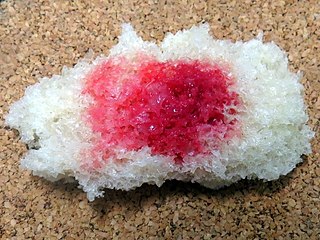
Denitrification is a microbially facilitated process where nitrate (NO3−) is reduced and ultimately produces molecular nitrogen (N2) through a series of intermediate gaseous nitrogen oxide products. Facultative anaerobic bacteria perform denitrification as a type of respiration that reduces oxidized forms of nitrogen in response to the oxidation of an electron donor such as organic matter. The preferred nitrogen electron acceptors in order of most to least thermodynamically favorable include nitrate (NO3−), nitrite (NO2−), nitric oxide (NO), nitrous oxide (N2O) finally resulting in the production of dinitrogen (N2) completing the nitrogen cycle. Denitrifying microbes require a very low oxygen concentration of less than 10%, as well as organic C for energy. Since denitrification can remove NO3−, reducing its leaching to groundwater, it can be strategically used to treat sewage or animal residues of high nitrogen content. Denitrification can leak N2O, which is an ozone-depleting substance and a greenhouse gas that can have a considerable influence on global warming.
Pseudoalteromonas is a genus of marine bacteria. In 1995, Gauthier et al proposed Pseudoalteromonas as a new genus to be split from Alteromonas. The Pseudoalteromonas species that were described before 1995 were originally part of the genus Alteromonas, and were reassigned to Pseudoalteromonas based on their rRNA-DNA analysis.
Paracoccus denitrificans, is a coccoid bacterium known for its nitrate reducing properties, its ability to replicate under conditions of hypergravity and for being a relative of the eukaryotic mitochondrion.
Alteromonas is a genus of Pseudomonadota found in sea water, either in the open ocean or in the coast. It is Gram-negative. Its cells are curved rods with a single polar flagellum.
Pseudoalteromonas atlantica is a marine bacterium, which has been shown to act as a primary producer of biofilms and exhibit virulence against Cancer pagurus, a species of crab, through secretion of extracellular products.

Corticovirus is a genus of viruses in the family Corticoviridae. Corticoviruses are bacteriophages; that is, their natural hosts are bacteria. The genus contains two species. The name is derived from Latin cortex, corticis. However, prophages closely related to PM2 are abundant in the genomes of aquatic bacteria, suggesting that the ecological importance of corticoviruses might be underestimated. Bacteriophage PM2 was first described in 1968 after isolation from seawater sampled from the coast of Chile.
Pseudoalteromonas agarivorans is a marine bacterium.
Pseudoalteromonas aurantia is an antibacterial-producing marine bacterium commonly found in Mediterranean waters. In 1979, Gauthier and Breittmayer first named it Alteromonas aurantia to include it in the genus Alteromonas that was described seven years earlier, in 1972 by Baumann et al. In 1995, Gauthier et al renamed Alteromonas aurantia to Pseudoalteromonas aurantia to include it in their proposed new genus, Pseudoalteromonas, which they recommended splitting from Alteromonas.
Pseudoalteromonas citrea is a yellow-pigmented marine bacterium that is antibiotic-producing and was isolated from Mediterranean waters off Nice. Originally named Alteromonas citrea, nearly two decades later it was reclassified as part of the Genus Pseudoalteromonas.
Pseudoalteromonas distincta is a marine bacterium.
Pseudoalteromonas elyakovii is a marine bacterium.
Pseudoalteromonas espejiana is a marine bacterium.
Pseudoalteromonas flavipulchra is a rod-shaped gram-negative marine bacterium.
Pseudoalteromonas rubra is a marine bacterium.
Pseudoalteromonas tetraodonis is a marine bacterium isolated from the surface slime of the puffer fish. It secretes the neurotoxin, tetrodotoxin. It was originally described in 1990 as Alteromonas tetraodonis but was reclassified in 2001 to the genus Pseudoalteromonas.
Pseudoalteromonas aliena is a marine, aerobic, heterotrophic bacterium that has been collected from Amur Bay.
Achromobacter denitrificans is a Gram-negative, oxidase- and catalase-positive, strictly aerobic, ubiquitous, motile bacterium with peritrichous flagella from the genus Achromobacter which was isolated from soil and can cause human infections.
Jonesia is a genus of Actinomycetota.
Thiobacillus denitrificans is a Gram-negative, obligate chemolithoautotroph. It was originally discovered by Martinus Beijerinck in 1904.

The prodiginines are a family of red tripyrrole dyestuffs produced by Gammaproteobacteria as well as some Actinomycetota. The group is named after prodigiosin (prodiginine) and is biosynthesized through a common set of enzymes. They are interesting due to their history and their varied biological activity.


